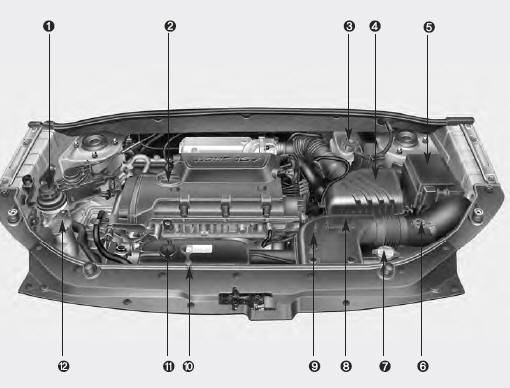 Kia Sportage: Engine compartment
Kia Sportage: Engine compartment
 2.0L Gasoline
Engine 1. Power steering fluid reservoir 2. Engine oil filler cap 3. Brake fluid
reservoir 4. Air cleaner 5. Fuse box 6. Negative battery terminal 7. Radiator cap
8. Positive battery terminal 9. Auto transaxle oil dipstick (if equipped) 10. Engine
oil dipstick 11. Engine coolant reservoir 12. Windshield washer fluid reservoir
The actual engine room in the vehicle may differ from the illustration.
2.0L Gasoline
Engine 1. Power steering fluid reservoir 2. Engine oil filler cap 3. Brake fluid
reservoir 4. Air cleaner 5. Fuse box 6. Negative battery terminal 7. Radiator cap
8. Positive battery terminal 9. Auto transaxle oil dipstick (if equipped) 10. Engine
oil dipstick 11. Engine coolant reservoir 12. Windshield washer fluid reservoir
The actual engine room in the vehicle may differ from the illustration.
 2.7L Gasoline
Engine 1. Power steering fluid reservoir 2. Engine oil filler cap 3. Brake fluid
reservoir 4. Air cleaner 5. Fuse box 6. Negative battery terminal 7. Radiator cap
8. Positive battery terminal 9. Auto transaxle oil dipstick (if equipped) 10. Engine
coolant reservoir 11. Engine oil dipstick 12. Windshield washer fluid reservoir
The actual engine room in the vehicle may differ from the illustration.
2.7L Gasoline
Engine 1. Power steering fluid reservoir 2. Engine oil filler cap 3. Brake fluid
reservoir 4. Air cleaner 5. Fuse box 6. Negative battery terminal 7. Radiator cap
8. Positive battery terminal 9. Auto transaxle oil dipstick (if equipped) 10. Engine
coolant reservoir 11. Engine oil dipstick 12. Windshield washer fluid reservoir
The actual engine room in the vehicle may differ from the illustration.
 Owner maintenance
Owner maintenance
Owner maintenance schedule The following lists are vehicle checks and inspections
that should be performed by the owner or an Authorized Kia Dealer at the frequencies
indicated to help ensure safe ...
 Engine oil and oil filter
Engine oil and oil filter
Checking the engine oil level 1. Be sure the vehicle is on level ground. 2. Start
the engine and allow it to reach normal operating temperature. 3. Turn the engine
off and wait for a few minut ...
See also:
Event Data Recorder (EDR)
This vehicle is equipped with an event data recorder
(EDR). The main purpose of an EDR is to record, in
certain crash or near crash-like situations, such as an air
bag deployment or hitting a ro ...
How OnStar Service Works
Automatic Crash Response, Emergency Services, Crisis Assist, Stolen Vehicle Assistance,
Vehicle Diagnostics, Remote Door Unlock, Roadside Assistance, Turn-by-Turn Navigation,
and Hands-Free Callin ...
Power seat (driver’s seat – if equipped)
1) Seat position forward/backward control
switch
To adjust the seat forward or backward,
move the control switch forward or
backward. During forward/backward adjustment of the seat, you canno ...
